CES 2009 - TV Trends, WirelessHD, 240Hz and Netbook Pricing
by Anand Lal Shimpi & Manveer Wasson on January 12, 2009 12:00 AM EST- Posted in
- Trade Shows
Toshiba Talks the Future of TVs
Toshiba was big on talking about the future of its LCD TVs at this year’s CES so we got a big tech demo of what’s to come.
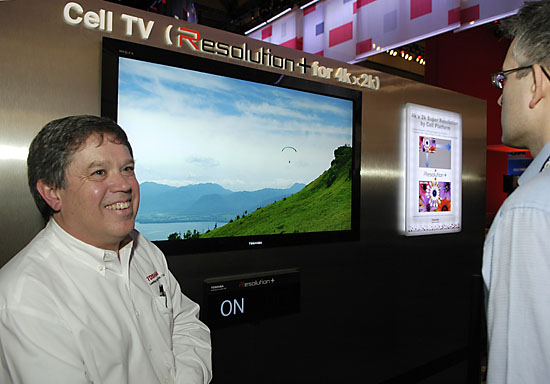
Tosh was the only manufacturer to say that 4K x 2K panels will be the future of LCD TVs, the rest were far more focused on today’s 1080p displays. The name is a bit misleading as the actual panel resolution is 3840 x 2160 (or 2 * 1920 x 2 * 1080). Since it’s an even multiple of 1080p, upscaling 1080p content to a 4K panel isn’t difficult - so existing content should adapt well to it. While 4K displays are still a while away, as soon as there’s content to support it, we’ll start seeing them.
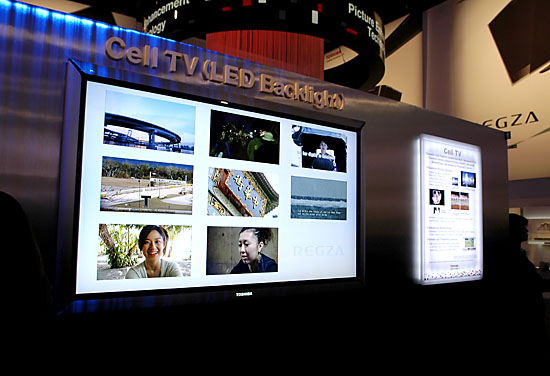
The 4K demo was done on Toshiba’s Cell powered TV. The Cell TV is powered by the same Cell processor that’s in Sony’s PlayStation 3, the difference being that here its used to drive the menu system and handles all upscaling of lower resolution content to the 4K panel. Additionally, the Cell processor runs the backlight dimming algorithm. The advantage here being that Cell is powerful enough to control more dimming zones than the Regza lineup’s current processor.
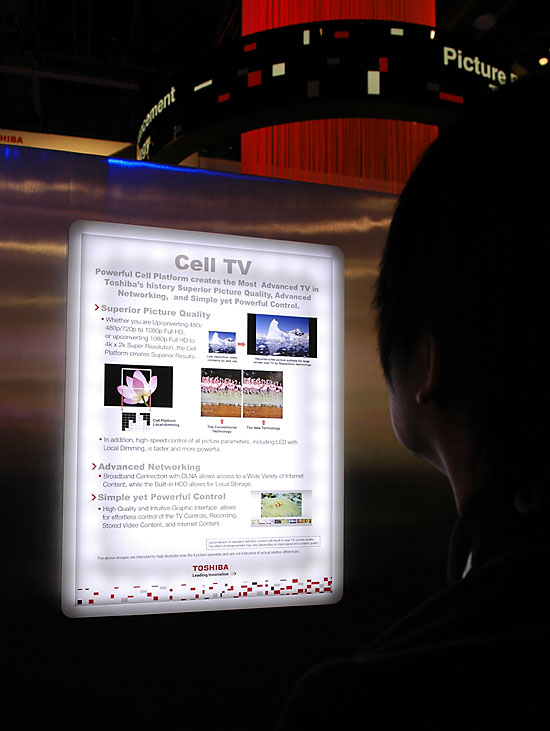
The Cell processor is also fast enough to decode 6 simultaneous HD streams at once. While you probably won’t watch six things at the same time, you could have a ridiculous picture in picture mode that’s very Back to the Future II-esque.
The rest of the technologies Toshiba talked about will be shipping on their 2009 model year Regza lineup.
Deep Lagoon is the name for Toshiba’s new bezel design. The idea is to make the panel and bezel seem as one. The bezel is black like the panel (but a more panel-like black) and is perforated as you get away from the panel to give it the appearance of fading away. The highest end Regza will have a bezel that is flush with the LCD panel.
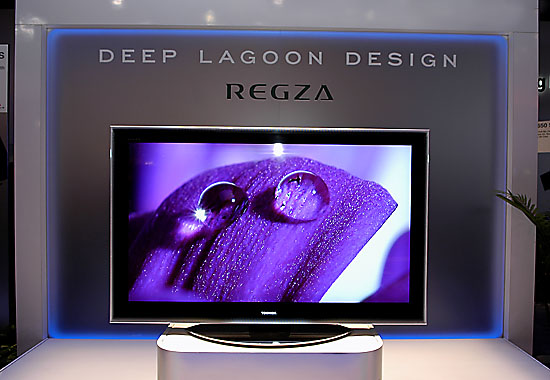
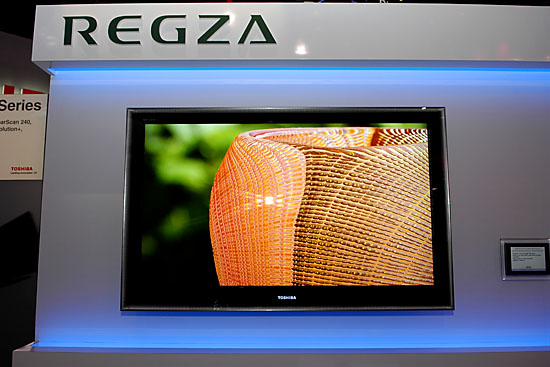
Toshiba’s TVs will also include a technology called Dolby Volume. A modern take on a solution to an old problem: how to deal with watching content with different volumes. You know the case, you’re watching a TV show at a particular volume and are interrupted by a commercial that’s far too loud.
TVs have shipped with adaptive volume for quite some time, but Toshiba argues that the old solution wasn’t good. The old solution used to be to simply apply a low pass filter that would eliminate high frequency audio. You’d get the impression of lower volumes but at the expense of actually losing some of the audio.
Dolby Volume keeps all of the audio; it simply compresses the spectrum. Louder sounds get quieter and quieter sounds get louder, allowing you to listen at low to normal volumes without worrying about blowing out your ears if an inconsiderate commercial airs.
As is the case with all spectrum-compressing technologies, audio purists may want to opt out. Most of these sorts of technologies in TVs (including overboosting colors) tend to appeal to the users who aren’t as in tune with (or don’t care about) what things are intended to look/sound like. It’s the same reason that distorting 16:9 stretch modes are so popular despite what they do to peoples’ faces. Dolby Volume appears to be a better solution to the volume problem, but unless you dynamically adjust the volume on your TV set, compressing the spectrum isn’t going to be the most acoustically pure solution.
Toshiba is including an Expert Mode on its 2009 LCD TVs. Although we didn’t get any additional information, it sounded like an easily accessible service menu, giving end users the same access that a calibrator would have without the risk associated with modifying settings in the service menu. We’d hope that more TV manufacturers would expose service-menu settings in a safer environment for the enthusiast market.
Toshiba talked about a feature called Instaport. When you turn the TV on it will perform the HDCP handshaking with all HDMI devices that are connected and turned on, so that switching between the HDMI inputs on the TV is faster. Toshiba didn’t demo the technology and it’s only useful if you have a bunch of devices turned on all the time, but it’s an attempt at addressing an annoying problem with current TVs.
Another Toshiba-only tech topic was 14-bit color processing on its Regza TVs. The LCD themselves don’t use 14-bit panels, but all processing is done internally with 14-bit resolution and then downsampled upon output. There are situations where 14-bit internal precision could help reduce color banding but I’m guessing that more often than not you won’t notice a difference.










30 Comments
View All Comments
Jaybus - Tuesday, January 13, 2009 - link
I doubt they chose the 60 GHz band just to avoid copyright problems. It is because of the bandwidth that they needed. 250 Mbps is not nearly enough. HDMI 1.0 specifies 4.9 Gbps for uncompressed transmission of 1080p60Hz plus 8-chan audio. HDMI 1.3 upped it to 10.3 Gbps to allow for higher resolutions. WirelessHD has a 7 GHz bandwidth on a 60 GHz carrier to achieve a max of around 25 Gbps. You obviously can't have a 7 GHz bandwidth with only a 5 GHz carrier frequency, so the carrier frequency had to be high to truly do HDMI wirelessly. Now why they chose 60 GHz as opposed to say 40 GHz may be because of transmission distance.Galvin - Monday, January 12, 2009 - link
4K LCD's scare me that just increases your chance of dead pixels by 2x. The sooner FED/SED tech is out the better. Cause that tech doesn't need all the fancy back lighting of LCD to handle blacks/whites.Plifzig - Monday, January 12, 2009 - link
Even worse, it increases your chances of getting dead pixels by 2X in the horizontal AND 2X in the vertical. Overall it's a 4X chance increase!2,073,600 pixels vs. 8,294,400 pixels
Denithor - Monday, January 12, 2009 - link
And can you imagine the GPU required to push a game for that resolution?SlyNine - Tuesday, January 13, 2009 - link
Geforce 256 SDR ?? ;)3DoubleD - Monday, January 12, 2009 - link
"Another potential benefit of full matrix LED backlighting is what Toshiba and some other manufacturers are calling the 240Hz effect. Last year we saw the beginnings of a move to 120Hz LCDs, which you may remember isn’t LCD panels with 120Hz refresh rates. There are only 60 frames of data displayed, the data in between two frames is simply interpolated on the fly effectively giving you 120 frames per second (but from only 60 frames worth of data)."Anand, this is one implementation of 120 Hz technology, but I fear it is the incorrect one. Many (if not all) TV manufacturers are producing TVs that use interpolation on 120 Hz TVs. This feature primarily targets sports as many complain about blurring while watching their favorite fast paced games on their several thousand dollar LCD TVs. This is the only time interpolation should be implemented as the effect is rather sickening for movie content. Interpolation of movie frames gives a rather "home video, handycam" sort of feel, completely ruining the experience.
120 Hz was used to allow both movie and tv content to be viewed without performing an uneven pulldown. On most TVs in the past, 24 Hz content (from Blu-rays, HD DVDs, and properly encoded movies and TV shows on the internet) required a 2:3 pulldown to be shown at 30 Hz and then doubled to the 60 Hz refresh rate of your TV to eliminate flickering. Unfortunately, the 2:3 pulldown isn't perfect and you get a phenomena called telcine judder or motion interpolation. This is very obvious during slow panning scenes, where the panning motion does not seem smooth, but jumps. The only way to properly handle 24 Hz material is to display it at a refresh rate at an even multiple of 24. Thus there are two options: offer two possible refresh rates on your TV (60 Hz and a multiple of 24 but greater than 60 (72 Hz or 96 Hz)), OR offer one refresh rate at 120 Hz as it is divisible by both 24 and 30 Hz.
TVs such as the Pioneer Kuro line offer the first implementation, where 60 and 72 Hz refresh rates are available. Most LCDs above ~$1500 CAD offer 120 Hz. With most of these 120 Hz LCDs, interpolation can be turned off for proper movie viewing. With all of this said, a TV that has a 240 Hz refresh rate is completely useless as 120 Hz solves the problem of displaying both 24 and 30 Hz content as well as offering interpolation for keen eyed sports fans.
However, the general public will never understand this... so let the Mhz wars begin (again)
Holly - Sunday, January 18, 2009 - link
You forget one thing... These 240Hz screens might be also inteded as a first step to shutter-glass aided 3D screen simulation. Giving each eye 120Hz is about reasonable refresh rate not to tire the eyes too much.strikeback03 - Monday, January 12, 2009 - link
If you turn off interpolation, wouldn't that leave 60Hz as the only option? Which would still not provide a multiple of 24 for movies.3DoubleD - Monday, January 12, 2009 - link
When you turn interpolation off it should due a 5:5 pulldown, which is simply playing the same frame 5 time in a row. However, some TVs don't do this and they should be avoided. This is something everyone should look for when shopping for a TV. Most TVs with 120 Hz capabilities have off-low-medium-high settings for their interpolation3DoubleD - Monday, January 12, 2009 - link
and by "due" I mean "do"... time for the afternoon coffee